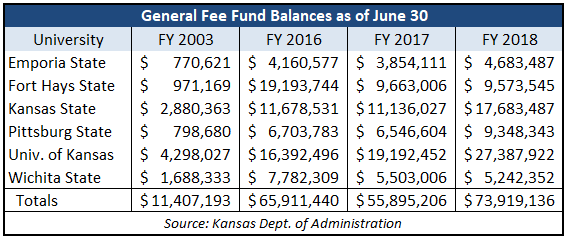Parents and students having to pay higher tuition and fees at Kansas universities might be surprised to know that $18 million of what they paid last year was used to pad university bank balances. That’s the collective net increase in General Fee Fund cash reserves reported in response to Open Records requests submitted by Kansas Policy Institute. Government funds operate much like a checking account; balances increase when more money is deposited than is spent.
The University of Kansas was the ‘worst offender’ last year, increasing the amount of unspent tuition and fees by $9.2 million and finishing the year with $27.4 million in that account. Kansas State University boosted its year-end balance to $17.7 million, up from $11.1 the year before. Pittsburg State used $2.8 million of tuition and fees to pad its fund balance, finishing with $9.3 million left over. Emporia state had the smallest increase at about $800,000 and the other two Regents universities – Fort Hays State and Wichita State – slightly reduced their tuition and fee cash reserves.

The June 30, 2018 balances for every university are exponentially higher than they were 15 years ago, when the collective total was just $11.4 million. Wichita State has the ‘smallest’ increase, more than tripling over the period and Pittsburg State has the largest percentage gain, growing by more than a factor of 12.
The General Fee Fund held by each university is just one of many funds each operates, and each school’s total cash reserves are much greater.
A downloadable list of fund balances for the nearly 2,400 funds held by state agencies and universities is at KansasOpenGov.org. The General Fund, by the way, is just one of those funds.




